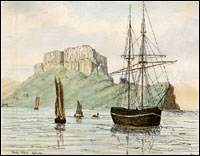












|

|
Down North on the Labrador Circuit:
The Court of Civil Jurisdiction 1826 to 1833
by Nina Jane Goudie
The Effects of World Events on Labrador
When Labrador reverted to Newfoundland in 1809, it was at the height of the island's economic boom. The main connection between Newfoundland and Labrador was through residents living along the north coast where about fifty percent of the island's population was concentrated. Between 150 and 200 boats, mostly from Trinity and Conception Bays, went to Labrador each year, employing up to 4,000 people. Patricia Thornton claims that the summer population along the Straits actually went as high as 30,000 on account of the American fishermen who, since the London Convention of 1818, had regained the right to fish along the coast of Labrador.31
Henley Island
Henley Island by Rev. William Grey, ca. 1857.
Drawing by Rev. William Grey. From William Grey, Sketches of Newfoundland and Labrador (Ipswitch, Eng.: S.H. Cowell, Anastatic Press, 1858).
 with more information (147 kb). with more information (147 kb).
|

|
Labrador's cod fishery developed considerably after 1815 when the French returned to claim their fishing rights along the French Shore and Newfoundlanders were no longer allowed to fish there. The end of war coupled with an economically depressed population in Newfoundland signaled a new emphasis on Labrador for fishing activities such that by the 1830s the cod and seal fisheries had grown to large-scale proportions.32 The fact that Labrador was separate from Newfoundland was of no consequence; in nautical terms the separation was merely a thoroughfare. The waters off the coast of Labrador had been fished for years but it was the growth of the seal fishery which initially brought permanent settlement and therefore long-term change to the coast. The permanent residents of Labrador had carried out a seal fishery for years but exports swelled owing to Europe's demand for seal oil as a lighting fuel. Neither fishery was viable in and of itself but the timing of the seasons complemented each other. In Newfoundland the sealing industry became a major branch of the cod fishery. Labrador, perhaps more than Newfoundland, had a diversified resource base which enabled settlers to earn an income year round. The spring seal fishery was followed by the cod fishery during the summer, a herring fishery carried through September and October and at the first sign of snow inhabitants moved inland where they trapped from October to March.33
Historians are the main source of population data up to 1857. Gosling reported thirteen settlers along the coast in 1763 and it seemed that hardly any Europeans lived there before the 1800s. Tanner estimated the population to be about 489 in 1806 and 2,000 in 1830. There is little known of the early settlers. Some immigrated from Newfoundland or England and perhaps some of the early French settlers remained. Tanner reported that the English language dominated the coast although it was not uncommon for people to speak French. According to Whiteley, when the Labrador fishery became popular there was already a string of small trading and fishing settlements from the Strait of Belle Isle as far north as Esquimaux Bay (Hamilton Inlet).34 Thornton's analysis of settlement patterns shows us that permanent settlement grew from 1815. Blanc Sablon, Forteau and L'Anse au Loup became commercial centres and it was “from there that life-blood emanated and circulated through the Strait of Belle Isle.” 35 35
Court records confirm commercial activity as well as mixed ethnicities. When Judge Paterson and his officers arrived in Indian Harbour in 1826 it was noted that,
William Cozens of Brigus had this year commenced a mercantile and fishing establishment which it is likely will be of consider-able magnitude, although this year there were not more than 25 persons employed by him. Besides which a good many of the Esquimaux Indians seem occasionally to beset this place — upwards of 20 of them being here at this time. Indian Harbor seems also much resorted to by the Americans. Six of their fishing schooners being here while the Indiana lay in port.... D. Brunet of Quebec have this year commenced a fishing establishment connected to their House in Rigolett...36
The multicultural nature of people along the Coast of Labrador was evident in this record. The extent to which these groups interacted is not documented in detail but the oral histories of Labradorians have linked their lineages to marriages between Inuit and whites that occurred during the early 1800s. This mixing of legal cultures must have added an interesting dimension to Paterson's work in resolving disputes. However, an absence of detailed information precludes a study into the pluralistic aspect of the legal system at this time.37
"Eskimo and Nascopi"
"Eskimo and Nascopi", author unknown, ca. 1861.
From Charles de Volpi, Newfoundland: a Pictorial Record (Sherbrooke, Quebec: Longman Canada Limited, ©1972) 91-92.
 with more information (124 kb). with more information (124 kb).
|

|
|

|

|

|



